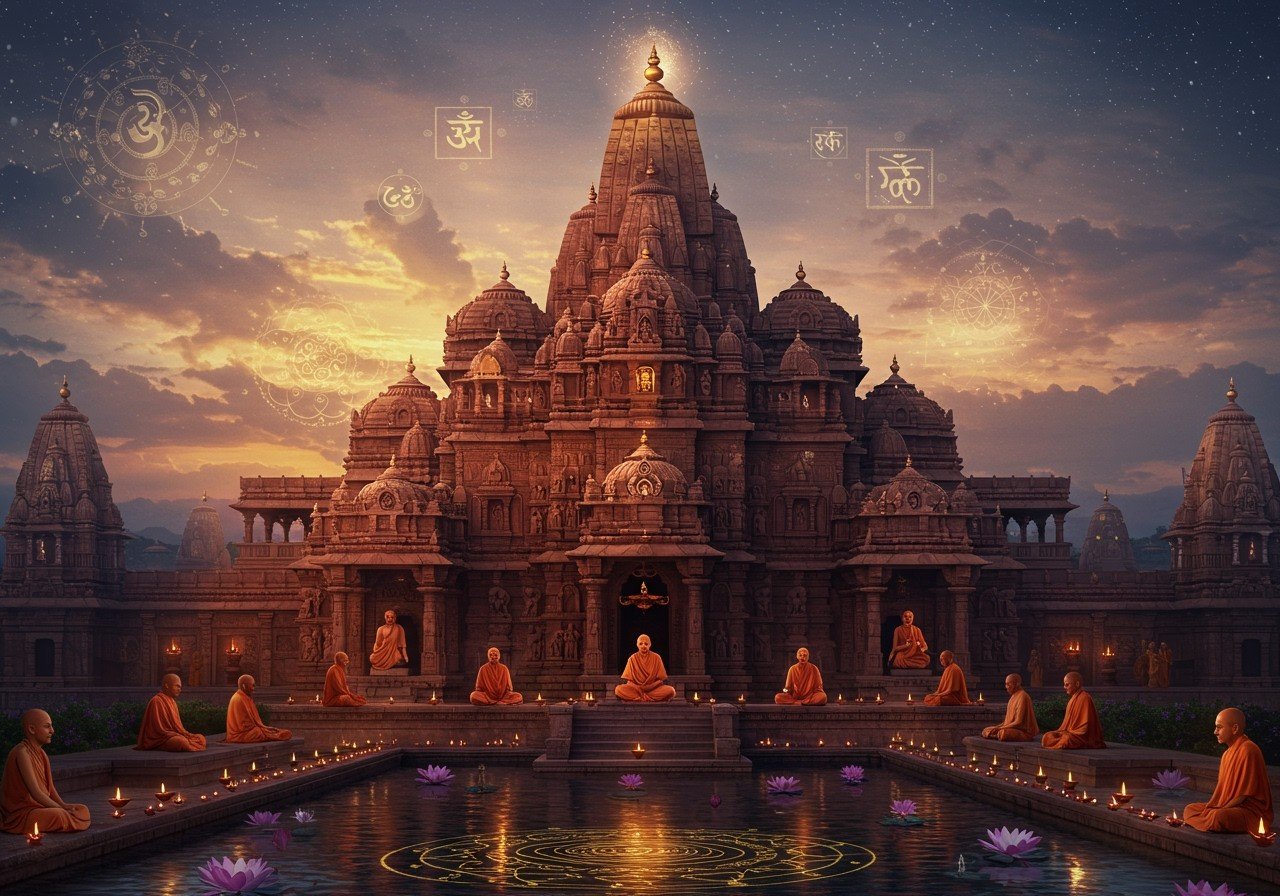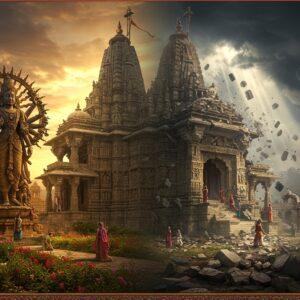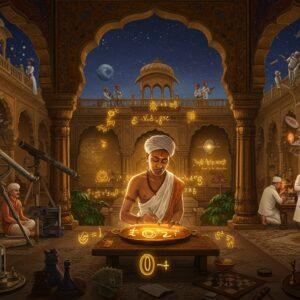
Hindu temples are not merely places of worship; they are integral to the cultural and spiritual fabric of Hindu society. These sacred spaces serve as vital centers for community gatherings, philosophical discourse, and vibrant cultural expression. Their architecture, steeped in symbolism, and the rituals performed within their walls reflect centuries of evolving religious thought and societal values. To truly appreciate their enduring significance, we must delve into this intertwined history of Hindu temples and the philosophy that underpins them.
The Essence of Hindu Philosophy
Hindu philosophy is anchored in core tenets such as Dharma (righteous conduct), Karma (the law of cause and effect), and Moksha (liberation from the cycle of rebirth). These fundamental principles permeate every aspect of temple rituals, architecture, and daily life. Sacred texts like the Vedas, Upanishads, and Bhagavad Gita, rich with philosophical insights, form the bedrock of temple activities and teachings. The intricate carvings, symbolic representations, and sacred ceremonies performed within the temple walls are designed to embody these philosophical ideas, inspiring reflection, devotion, and a deeper understanding of existence.
The Evolution of Hindu Temples
Over millennia, the Hindu temple system has undergone a remarkable transformation, evolving from simple shrines to magnificent architectural marvels. Early cave temples, carved into the heart of mountains, gradually gave way to elaborate structures like the awe-inspiring Brihadeeswarar Temple in Tamil Nadu, a testament to human ingenuity and devotion. Distinct architectural styles such as Dravidian, Nagara, and Vesara emerged, reflecting regional influences and artistic innovations. This evolution reflects the dynamic interplay of political, cultural, and religious forces, demonstrating how temples adapted to the changing needs and aspirations of society.
Temples: Centers of Learning and Wisdom
In ancient India, Hindu temples served as vibrant hubs of education and philosophical discourse. They housed schools, libraries, and lively debating halls where Vedic scriptures, the arts, and sciences were studied and discussed. Priests and scholars played a crucial role in disseminating philosophical knowledge, fostering intellectual growth and spiritual understanding. This rich intellectual environment solidified the temple’s position as a center for spiritual guidance, shaping the minds and hearts of generations.
The Interplay of Rituals and Philosophy
Temple rituals are deeply intertwined with Hindu philosophical principles. Daily ceremonies, elaborate festivals, and sacred rites are expressions of concepts like Bhakti (devotion) and Yajna (sacrifice). These rituals not only create a sacred atmosphere conducive to meditation and reflection but also offer symbolic representations of philosophical teachings, guiding devotees towards spiritual enlightenment. Each act, each offering, carries a deeper meaning, connecting the individual to the divine and the universal.
Delving Deeper: Resources for Understanding
Numerous books and resources explore the profound depths of Hindu philosophy and the intricate beauty of temple architecture. Classic texts like the Vedas and Upanishads, along with contemporary interpretations, offer invaluable insights into these interconnected subjects. For Telugu speakers, regional resources provide an opportunity to deepen understanding in their native language. Explore these valuable materials to gain a richer appreciation for the cultural and spiritual significance of Hindu temples.
Hindu Philosophy Explained: A Beginner’s Guide
Hindu Temples: Sanctuaries of the Divine
Hindu temples, often referred to as Mandirs, Devasthanams, Puras, or Kovils, are sacred sanctuaries where devotees connect with the divine through prayer, offerings, and rituals. These consecrated spaces are considered the dwelling place of the deities they honor, making them central to spiritual practice and community life. Here, individuals seek blessings, express their devotion, and experience a profound connection with the sacred.
Architecture: A Reflection of the Cosmos
Hindu temple architecture, with roots in later Vedic traditions, is a symbolic representation of the cosmos. The use of squares and circles in temple design illustrates the principles of recursion and the interconnectedness of the microcosm and macrocosm. The layout often reflects the mandala, a geometric representation of the universe, with the Garbhagriha (sanctum sanctorum) at the center, housing the main deity. The towering Shikhara or Vimana symbolizes the sacred mountain, reaching towards the heavens, while the Gopuram, the entrance gateway, marks the transition from the material to the spiritual realm. Every element of the temple’s design is imbued with symbolic meaning, inviting devotees to contemplate the mysteries of the universe.
Symbolism: A Language of the Sacred
Hindu temples are rich in symbolism, reflecting the cosmological and philosophical principles of Hinduism. They incorporate elements of the Hindu pantheon, such as fire, water, representations of nature, deities, and the interplay of masculine and feminine energies. Carvings of gods, goddesses, mythological scenes, and cosmic symbols adorn the temple walls, elevating the mind and spirit of devotees. These visual narratives offer profound insights into Hindu beliefs and values, inspiring contemplation and reverence.
Design Philosophy: Unity and Interconnection
The design of Hindu temples is based on the profound belief that all things are interconnected. The Vastu Purusha Mandala, a mystical diagram, serves as the foundation for temple design, with the most sacred layout being the 8×8 grid. The temple’s design also reflects the four primary aims of human life: Artha (prosperity and material well-being), Kama (pleasure and fulfillment), Dharma (righteous conduct and moral duty), and Moksha (liberation and self-realization). These principles are woven into the very fabric of the temple, guiding devotees towards a balanced and meaningful life.
Significance: A Bridge Between the Human and Divine
A Hindu temple is a synthesis of arts, ideals of Dharma, beliefs, values, and the Hindu way of life. It acts as a bridge between humans, deities, and the Universal Purusha within a sacred space, mapping the intricate relationships between the cosmos and the individual. Temples are not just physical structures; they are living expressions of faith, devotion, and the pursuit of spiritual understanding.
Beyond the Temple: India’s Spiritual Heart Revealed
Practices: Pathways to Devotion
Temples are designed to facilitate the worship of deities through a variety of rituals, offerings, and prayers. Devotees visit temples to seek blessings, offer gratitude, and connect with the divine. Key practices include Pradakshina, the circumambulation around the deity’s sanctuary, symbolizing the cycle of rebirths, and the offering of symbolic items such as fruits, flowers, and sweets. These acts of devotion create a sacred bond between the worshipper and the divine, fostering a sense of peace, reverence, and spiritual connection. You can buy flowers, fruits, sweets and other pooja samagri online at Poojn.in.
Hindu Philosophy: An Ancient Wisdom Tradition
Hindu philosophy, one of the world’s oldest continuous philosophical traditions, delves into profound questions of existence, knowledge, language, and morality. It encompasses a vast body of thought, spanning millennia, and has shaped not only religious beliefs but also cultural practices, social structures, and artistic expressions. Connecting With Your Inner Self: A Hindu Philosophy Guide
Core Concepts: Foundations of Belief
-
Atman: The eternal, unchanging individual self or soul, the essence of one’s being.
-
Brahman: The ultimate reality, the cosmic principle, the source and ground of all existence, encompassing the Atman.
-
Karma: The universal law of cause and effect, where actions and thoughts determine one’s present and future lives, shaping the journey of the soul.
-
Samsara: The continuous cycle of birth, death, and rebirth, driven by karma, a journey of the soul through various lifetimes.
-
Moksha: Liberation from the cycle of Samsara, the ultimate goal of spiritual practice, achieving union with Brahman. Mangalam Camphor Butter Paper 400g Approx 200 Pieces helps in spiritual practices.
-
Dharma: Righteous conduct, moral duty, the principles of living a virtuous and fulfilling life, aligning with cosmic order. You can buy different types of dhoop at Poojn.in.
Schools of Thought: Diverse Perspectives
Hindu philosophy is not monolithic; it embraces a rich diversity of thought through various schools known as Darshanas. Each school offers a unique perspective on reality and the path to liberation. The six major orthodox (Astika) schools – Nyaya, Vaisheshika, Samkhya, Yoga, Purva Mimamsa, and Vedanta – accept the authority of the Vedas as sacred scriptures. These schools engage in rigorous philosophical inquiry, exploring the nature of reality, consciousness, and the universe.
Influence: Shaping Indian Thought and Beyond
Hindu philosophy has had a profound influence on other Indian religions, including Buddhism, Jainism, and Sikhism. It shares common themes, such as the emphasis on liberation from suffering, and utilizes similar epistemic tools and methods of argumentation. The impact of Hindu thought extends beyond religious boundaries, influencing various fields of knowledge, including art, literature, and ethics. You can find a wide range of puja items online at Poojn.in.
Temple Connection: Philosophy Embodied in Stone
Hindu temples are not merely places of worship; they are physical embodiments of Hindu philosophy. Their architecture, symbolism, and rituals reflect fundamental concepts about the nature of the cosmos, the journey of the soul, and the path to liberation. The temple serves as a tangible link between the gods and humans, facilitating the understanding of cosmic principles and guiding devotees towards spiritual enlightenment. Hindu Symbols Explained: Their Meanings and Importance
Poojn.in: Your Partner in Spiritual Practice
Poojn.in is proud to support your spiritual journey by providing a wide selection of authentic puja items and religious materials. Our offerings are carefully curated to align with Hindu philosophical traditions and temple customs. We are committed to providing high-quality, genuine products that enhance your connection with the divine.
Explore our diverse collection, which includes:
- Temple bells and ghanti
- Puja thali sets
- Brass and copper items
- Ritual accessories
- Worship materials
- Sacred texts
Contact our dedicated team at 91 3369029784 for personalized assistance with your temple and religious needs. Poojn.in is dedicated to preserving the sanctity of religious practices by offering authentic items conveniently accessible across India. Visit us at Poojn.in to explore our extensive collection.
Conclusion: A Timeless Journey of Faith and Understanding
Hindu temples and philosophy, intertwined through centuries of tradition and devotion, offer a rich tapestry of spiritual and cultural heritage. Temples stand as enduring symbols of ancient wisdom, guiding devotees on their unique spiritual journeys. They provide sacred spaces for reflection, worship, and connection with the divine. These timeless structures, with their intricate designs and profound symbolism, embody the essence of Hindu philosophy, inviting all to explore the depths of their beliefs. As you delve into this interconnected history, remember that a temple is not merely a place; it is a journey through time, a pathway to understanding life’s ultimate truths. Whether you are visiting a temple or studying its underlying philosophy, you are engaging with a tradition that has shaped and continues to enrich Indian culture and spirituality.


